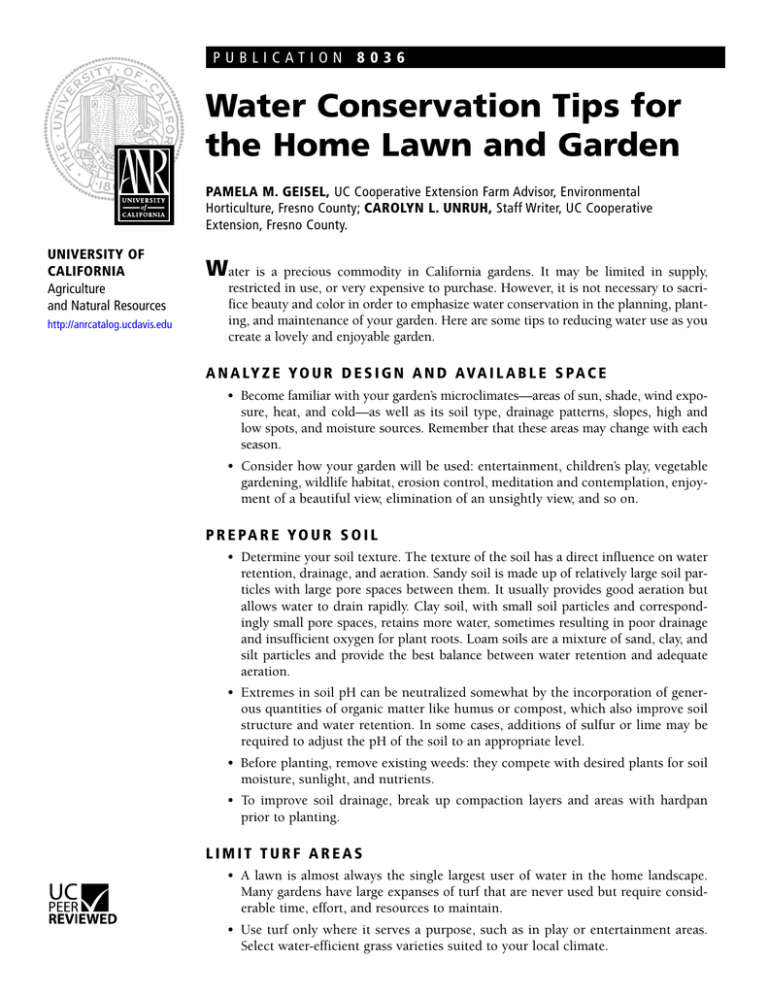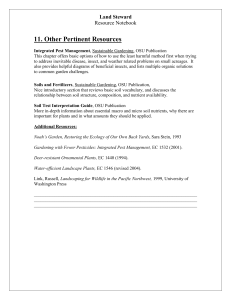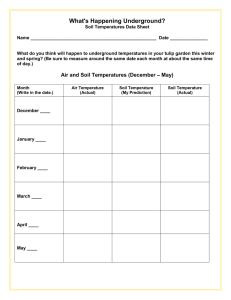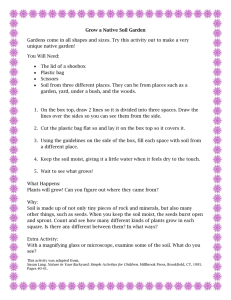
PUBLICATION 8036
Water Conservation Tips for
the Home Lawn and Garden
PAMELA M. GEISEL, UC Cooperative Extension Farm Advisor, Environmental
Horticulture, Fresno County; CAROLYN L. UNRUH, Staff Writer, UC Cooperative
Extension, Fresno County.
UNIVERSITY OF
CALIFORNIA
Agriculture
and Natural Resources
http://anrcatalog.ucdavis.edu
Water is a precious commodity in California gardens. It may be limited in supply,
restricted in use, or very expensive to purchase. However, it is not necessary to sacrifice beauty and color in order to emphasize water conservation in the planning, planting, and maintenance of your garden. Here are some tips to reducing water use as you
create a lovely and enjoyable garden.
A N A LY Z E Y O U R D E S I G N A N D A V A I L A B L E S P A C E
• Become familiar with your garden’s microclimates—areas of sun, shade, wind exposure, heat, and cold—as well as its soil type, drainage patterns, slopes, high and
low spots, and moisture sources. Remember that these areas may change with each
season.
• Consider how your garden will be used: entertainment, children’s play, vegetable
gardening, wildlife habitat, erosion control, meditation and contemplation, enjoyment of a beautiful view, elimination of an unsightly view, and so on.
P R E PA R E YO U R S O I L
• Determine your soil texture. The texture of the soil has a direct influence on water
retention, drainage, and aeration. Sandy soil is made up of relatively large soil particles with large pore spaces between them. It usually provides good aeration but
allows water to drain rapidly. Clay soil, with small soil particles and correspondingly small pore spaces, retains more water, sometimes resulting in poor drainage
and insufficient oxygen for plant roots. Loam soils are a mixture of sand, clay, and
silt particles and provide the best balance between water retention and adequate
aeration.
• Extremes in soil pH can be neutralized somewhat by the incorporation of generous quantities of organic matter like humus or compost, which also improve soil
structure and water retention. In some cases, additions of sulfur or lime may be
required to adjust the pH of the soil to an appropriate level.
• Before planting, remove existing weeds: they compete with desired plants for soil
moisture, sunlight, and nutrients.
• To improve soil drainage, break up compaction layers and areas with hardpan
prior to planting.
LIMIT TURF AREAS
• A lawn is almost always the single largest user of water in the home landscape.
Many gardens have large expanses of turf that are never used but require considerable time, effort, and resources to maintain.
• Use turf only where it serves a purpose, such as in play or entertainment areas.
Select water-efficient grass varieties suited to your local climate.
ANR Publication 8036
WATER CONSERVATION TIPS FOR THE HOME LAWN AND GARDEN
• Replace nonessential turf with ground covers, mulches, or hardscapes such as
decks, walkways, patios, or dry creeks.
PUT PLANTS IN THE RIGHT PLACES
• Select low water use plants that are appropriate to your climate. Consider the use
of California natives from your climate zone. Most need regular watering until
they are established, but will require less water thereafter.
• For ease of irrigation, group plants with similar microclimatic needs in the same
watering zone. Lawns, water-loving plants, and container plants require frequent
irrigation while many trees, shrubs, perennials, bulbs, and ground covers need
less frequent irrigation. Established trees and plants may need just a little more
water than they receive in rainfall, and some established, drought-tolerant trees,
shrubs, and ground covers may survive with average rainfall alone.
• Limit the use of ornamentals that require frequent irrigation and group them in
areas where they can be watered together. Productive garden areas, such as a vegetable bed, may also require larger amounts of water than the surrounding landscape. Plant low water users farther away from the house or where irrigation may
not be as readily available.
I R R I G A T E E F F I C I E N T LY
• Water only as much as is necessary and adjust your irrigation schedule periodically—each month, ideally—to reflect seasonal changes in temperature, wind,
humidity, and rainfall. Your irrigation system should be customized to provide
only as much water as is needed for each grouping of plants.
• Extreme differences in microclimate areas require distinctly different irrigation
regimens and should be irrigated with separate valves or systems.
• Use an efficient watering system such as drip or soaker hoses to minimize water
loss through evaporation or runoff. Turf is best irrigated with sprinklers.
• To further reduce evaporation, operate your irrigation system during the cooler hours
of the early morning rather than during the heat of the day or in windy weather.
• Infrequent, deep watering encourages deeper root growth and results in plants
with greater tolerance of fluctuations in soil moisture.
• Check your irrigation system regularly for leaks, broken heads, faulty valves, and
other malfunctions. Be sure that misdirected water is not running off onto driveways, sidewalks, or streets.
MULCH, MULCH, MULCH!
• A thick layer (3 inches or more) of coarse mulch acts as insulation for your soil
and significantly reduces evaporation of soil moisture. Mulching helps maintain a
consistent soil temperature and protects roots from the heat and drying effects of
summer weather.
• Keep mulch several inches away from the trunks of trees or shrubs as it may
harbor insects or pathogens that promote root and crown diseases such as
Phytophthora root rot (Phytophthora spp.).
• Mulch can effectively reduce weed growth by blocking the sunlight needed for
weed seeds to germinate. This reduces competition for soil moisture and reduces
the time needed for garden maintenance.
2
ANR Publication 8036
WATER CONSERVATION TIPS FOR THE HOME LAWN AND GARDEN
• Organic mulches such as bark products, humus, and leaves break down over time,
resulting in improved soil structure and the slow release of small amounts of nutrients.
• The soil under the mulch should be checked periodically to be sure that irrigation
water is reaching the soil and the root zone of desired plants.
A P P R O P R I AT E M A I N T E N A N C E
• Heavy pruning can lead to excessive plant growth and increased demand for
water. To shape and direct plant growth, prune lightly during the winter dormant
season or very early spring.
• The overuse of fertilizers results in rank growth and heavy water consumption.
Apply nutrients only when plants need them and use low concentrations or slowrelease formulations.
• Reduce weeding chores by pulling unwanted plants before they mature and produce seeds. Weed growth can be kept in check with the use of mulches and dense
ground covers to block sunlight from reaching weed seeds.
• Mow lawns somewhat higher during very warm weather. This reduces the growth
rate and the demand for water, promotes deeper root growth, and lessens the likelihood of sunburn injury. Taller turf shades the soil and reduces weed seed germination.
3
ANR Publication 8036
4
WATER CONSERVATION TIPS FOR THE HOME LAWN AND GARDEN
F O R M O R E I N F O R M AT I O N
You’ll find detailed information on many aspects of managing the home landscape
in these titles and in other publications, slide sets, and videos from UC ANR:
Turfgrass Water Conservation, Publication 21405
Drip Irrigation in the Home Landscape, Publication 21579
Pests of Landscape Trees and Shrubs: An Integrated Pest Management Guide,
Publication 3359
The UC Guide to Solving Garden and Landscape Problems, CD-ROM ANR3400
To order these products, visit our online catalog at http://anrcatalog.ucdavis.edu.
You can also place orders by mail, phone, or fax, or request a printed catalog of
publications, slide sets, and videos from
University of California
Division of Agriculture and Natural Resources
Communication Services
6701 San Pablo Avenue, 2nd Floor
Oakland, CA 94608-1239
Telephone: (800) 994-8849 or (510) 642-2431, FAX: (510) 643-5470
E-mail inquiries: danrcs@ucdavis.edu
An electronic version of this publication is available on the ANR Communication Services website at
http://anrcatalog.ucdavis.edu.
Publication 8036
This publication was funded in part by the Elvenia J. Slosson Fund.
The information in this publication was adapted from Landscaping for the Future: A Guide to Central Valley
Gardening by P. D. Elam, D. F. Zoldoske, G. Jorgensen, J. Valentino, and V. Nolleti.
(Fresno, CA: The Fresno Bee, 1991).
©2001 by the Regents of the University of California, Division of Agriculture and Natural Resources.
All rights reserved.
The University of California prohibits discrimination against or harassment of any person employed by or
seeking employment with the University on the basis of race, color, national origin, religion, sex, physical
or mental disability, medical condition (cancer-related or genetic characteristics), ancestry, marital status,
age, sexual orientation, citizenship, or status as a covered veteran (special disabled veteran, Vietnam-era veteran or any other veteran who served on active duty during a war or in a campaign or expedition for which
a campaign badge has been authorized). University Policy is intended to be consistent with the provisions
of applicable State and Federal laws.
Inquiries regarding the University’s nondiscrimination policies may be directed to the Affirmative
Action/Staff Personnel Services Director, University of California, Agriculture and Natural Resources, 300
Lakeside Drive, 6th floor, Oakland, CA 94612-3550; 510-987-0096. For a free catalog of other publications, telephone 800-994-8849.
pr-09/01-GM/VFG
ISBN 978-1-60107-214-6
This publication has been anonymously peer reviewed for technical accuracy by University of California
scientists and other qualified professionals. This review process was managed by the ANR Associate Editor for
Environmental Horticulture.




